July 30, 2025 — A devastating 8.8-magnitude earthquake struck deep beneath the Pacific Ocean early Wednesday, unleashing powerful tsunami waves that battered coastlines across multiple nations. The seismic event, one of the strongest recorded in recent years, triggered widespread destruction and forced emergency evacuations from Japan to the South Pacific.

Epicenter and Seismic Impact
The quake occurred at approximately 4:12 a.m. local time, with its epicenter located nearly 150 kilometers southeast of the Solomon Islands at a depth of about 35 kilometers. Tremors were felt as far as Papua New Guinea, Fiji, and even parts of eastern Australia. Early reports from the United States Geological Survey (USGS) confirm the earthquake’s magnitude at 8.8, classifying it as a “major” quake capable of causing catastrophic damage.
Tsunami Alerts and Coastal Damage
Within minutes, the Pacific Tsunami Warning Center (PTWC) issued emergency alerts for dozens of countries bordering the Pacific Rim, including Indonesia, Japan, the Philippines, and Hawaii. Tsunami waves ranging from one to three meters high struck low-lying areas, damaging infrastructure, sweeping away boats, and flooding coastal communities.
In the Solomon Islands, one of the hardest-hit nations, waves surged inland by more than 500 meters in some places, destroying homes, uprooting trees, and leaving hundreds displaced. Local authorities report at least 25 confirmed fatalities so far, with many more missing or injured.
Emergency Response Underway
National governments and international relief agencies have mobilized emergency response teams. Rescue operations are ongoing in isolated villages where access is limited due to collapsed roads and downed communication lines.
Japanese Prime Minister Hidetaka Sano addressed the nation, stating: “We are closely monitoring the situation. Evacuation orders remain in place in several coastal regions. Our emergency services are coordinating with local governments to ensure the safety of all residents.”
In the Philippines, swift evacuations reportedly saved many lives in the eastern provinces, though several fishing communities have been severely affected.
Global Reactions and Support
The United Nations Office for the Coordination of Humanitarian Affairs (OCHA) announced it is deploying assessment teams to affected areas. Several countries, including Australia, New Zealand, and the United States, have offered humanitarian aid, search-and-rescue support, and emergency funding.
“We are ready to support our Pacific neighbors in this time of crisis,” said U.S. Secretary of State Linda Holbrook. “This is a moment for global solidarity.”
Concerns About Aftershocks
Seismologists warn that significant aftershocks are likely in the coming days, which could trigger further tsunami threats or structural collapses. Coastal residents are urged to remain alert and heed local advisories.
Looking Ahead
This event has reignited discussions around earthquake preparedness and tsunami warning systems across the Pacific. Despite the tragedy, many experts noted that improvements in early warning technology and rapid response protocols likely prevented even greater loss of life.
As the region begins to recover from this disaster, the full scale of the damage and the long-term impact on affected communities will become clearer in the days and weeks ahead.

















